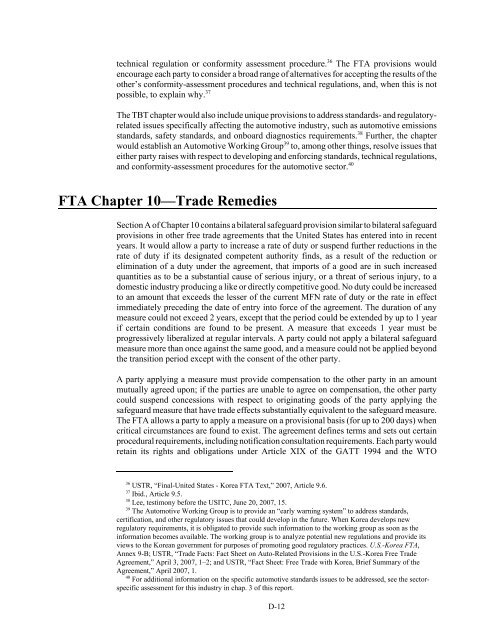U.S.-Korea Free Trade Agreement: Potential Economy-wide ... - USITC
U.S.-Korea Free Trade Agreement: Potential Economy-wide ... - USITC
U.S.-Korea Free Trade Agreement: Potential Economy-wide ... - USITC
You also want an ePaper? Increase the reach of your titles
YUMPU automatically turns print PDFs into web optimized ePapers that Google loves.
technical regulation or conformity assessment procedure. 36 The FTA provisions would<br />
encourage each party to consider a broad range of alternatives for accepting the results of the<br />
other’s conformity-assessment procedures and technical regulations, and, when this is not<br />
possible, to explain why. 37<br />
The TBT chapter would also include unique provisions to address standards- and regulatoryrelated<br />
issues specifically affecting the automotive industry, such as automotive emissions<br />
standards, safety standards, and onboard diagnostics requirements. 38 Further, the chapter<br />
would establish an Automotive Working Group 39 to, among other things, resolve issues that<br />
either party raises with respect to developing and enforcing standards, technical regulations,<br />
and conformity-assessment procedures for the automotive sector. 40<br />
FTA Chapter 10—<strong>Trade</strong> Remedies<br />
Section A of Chapter 10 contains a bilateral safeguard provision similar to bilateral safeguard<br />
provisions in other free trade agreements that the United States has entered into in recent<br />
years. It would allow a party to increase a rate of duty or suspend further reductions in the<br />
rate of duty if its designated competent authority finds, as a result of the reduction or<br />
elimination of a duty under the agreement, that imports of a good are in such increased<br />
quantities as to be a substantial cause of serious injury, or a threat of serious injury, to a<br />
domestic industry producing a like or directly competitive good. No duty could be increased<br />
to an amount that exceeds the lesser of the current MFN rate of duty or the rate in effect<br />
immediately preceding the date of entry into force of the agreement. The duration of any<br />
measure could not exceed 2 years, except that the period could be extended by up to 1 year<br />
if certain conditions are found to be present. A measure that exceeds 1 year must be<br />
progressively liberalized at regular intervals. A party could not apply a bilateral safeguard<br />
measure more than once against the same good, and a measure could not be applied beyond<br />
the transition period except with the consent of the other party.<br />
A party applying a measure must provide compensation to the other party in an amount<br />
mutually agreed upon; if the parties are unable to agree on compensation, the other party<br />
could suspend concessions with respect to originating goods of the party applying the<br />
safeguard measure that have trade effects substantially equivalent to the safeguard measure.<br />
The FTA allows a party to apply a measure on a provisional basis (for up to 200 days) when<br />
critical circumstances are found to exist. The agreement defines terms and sets out certain<br />
procedural requirements, including notification consultation requirements. Each party would<br />
retain its rights and obligations under Article XIX of the GATT 1994 and the WTO<br />
36 USTR, “Final-United States - <strong>Korea</strong> FTA Text,” 2007, Article 9.6.<br />
37 Ibid., Article 9.5.<br />
38 Lee, testimony before the <strong>USITC</strong>, June 20, 2007, 15.<br />
39 The Automotive Working Group is to provide an “early warning system” to address standards,<br />
certification, and other regulatory issues that could develop in the future. When <strong>Korea</strong> develops new<br />
regulatory requirements, it is obligated to provide such information to the working group as soon as the<br />
information becomes available. The working group is to analyze potential new regulations and provide its<br />
views to the <strong>Korea</strong>n government for purposes of promoting good regulatory practices. U.S.-<strong>Korea</strong> FTA,<br />
Annex 9-B; USTR, “<strong>Trade</strong> Facts: Fact Sheet on Auto-Related Provisions in the U.S.-<strong>Korea</strong> <strong>Free</strong> <strong>Trade</strong><br />
<strong>Agreement</strong>,” April 3, 2007, 1–2; and USTR, “Fact Sheet: <strong>Free</strong> <strong>Trade</strong> with <strong>Korea</strong>, Brief Summary of the<br />
<strong>Agreement</strong>,” April 2007, 1.<br />
40 For additional information on the specific automotive standards issues to be addressed, see the sectorspecific<br />
assessment for this industry in chap. 3 of this report.<br />
D-12

















